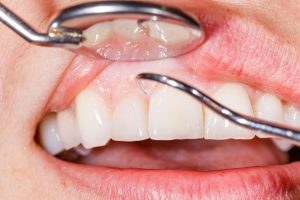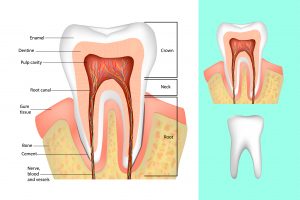Digital Radiography is an exciting, new technology that offers many advantages over traditional x-rays. Traditionally, dentists find out what’s going on inside your mouth by taking a series of x-rays that need to be developed in a darkroom using strong chemicals. After they dry out these small (usually about 1 square inch) films are viewed on a special lighted screen. This time-consuming process is no longer necessary due to Digital 
Instead of film, a tiny sensor is positioned briefly inside your mouth. The sensor acts like a miniature camera that is sensitive to x-rays rather than light. The images are instantly transmitted to a computer monitor where they are easily seen by both you and us. The images can be magnified, the contrast and brightness can be adjusted, and any areas of concern can be “zoomed-in” on, making diagnosis much more accurate. The radiation levels our patients are exposed to are now less than one-third of traditional x-rays. The chemicals that once were needed are no longer going into the water system, eliminating that form of pollution. Images can be more easily stored; can be transmitted electronically to insurance companies or specialists and the problem of fading x-ray images over time is eliminated.
Digital Radiography has become an integral part of “state of the art” dentistry in the 21st Century.
If you, your family or friends need dental care, we would be honored to provide you with state-of-the-art dental care in our modern dental practice. Refer someone you love to someone you trust!
Presented as a service to the community by Doctors Hoover and Yanda,
39 Milford Drive, Hudson, Ohio 44236. 330-650-0360. www.drshooverandyanda.com

 and clogging of the arteries with fatty substances called lipids. Immune cells stick to the walls of blood vessels, scavenge lipids, and multiply. The blood vessel walls inflame and thicken as the smooth muscle cells lining them change, swelling and dividing to create plaques, clogs, and warty growths called atheromas.
and clogging of the arteries with fatty substances called lipids. Immune cells stick to the walls of blood vessels, scavenge lipids, and multiply. The blood vessel walls inflame and thicken as the smooth muscle cells lining them change, swelling and dividing to create plaques, clogs, and warty growths called atheromas. becomes deep enough, it exposes the pulp of the tooth to the bacteria that cause infection. Your body fights the infection by sending increased blood flow to the area. But because the tooth’s nerve and pulp are encased in enamel, pressure builds inside the tooth as a result of the increased blood flow. Swelling and pain begin.
becomes deep enough, it exposes the pulp of the tooth to the bacteria that cause infection. Your body fights the infection by sending increased blood flow to the area. But because the tooth’s nerve and pulp are encased in enamel, pressure builds inside the tooth as a result of the increased blood flow. Swelling and pain begin. brushing techniques, the importance of limiting sugary drinks, and the need to avoid putting children to bed with a bottle.
brushing techniques, the importance of limiting sugary drinks, and the need to avoid putting children to bed with a bottle. them over a prolonged period and holding them in the mouth is not good. The acid dissolves minerals in the enamel, making it thinner.
them over a prolonged period and holding them in the mouth is not good. The acid dissolves minerals in the enamel, making it thinner.